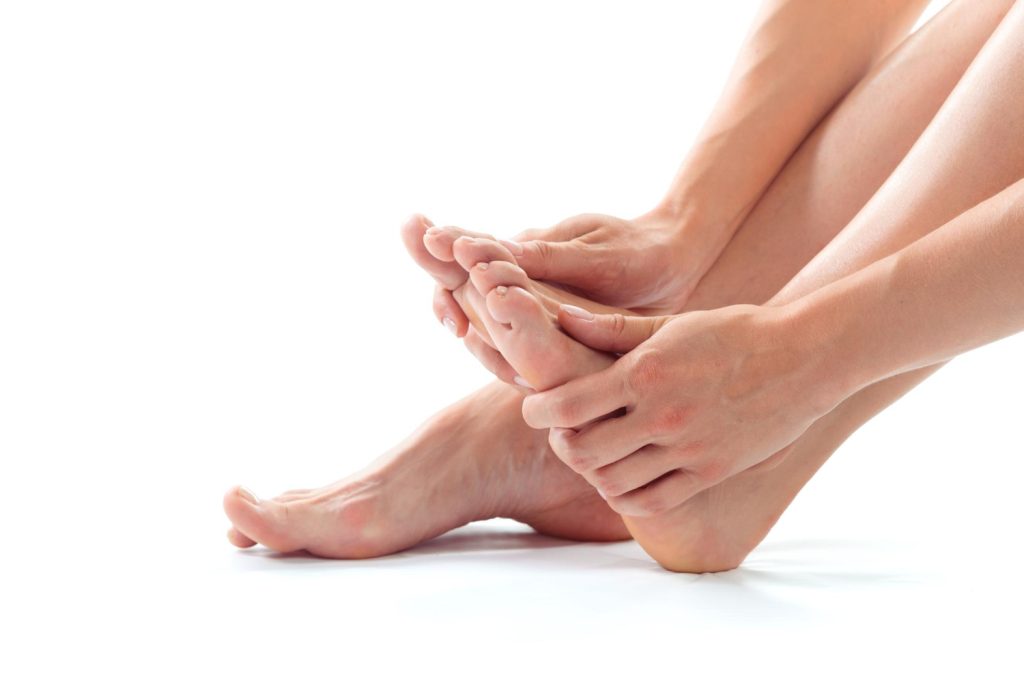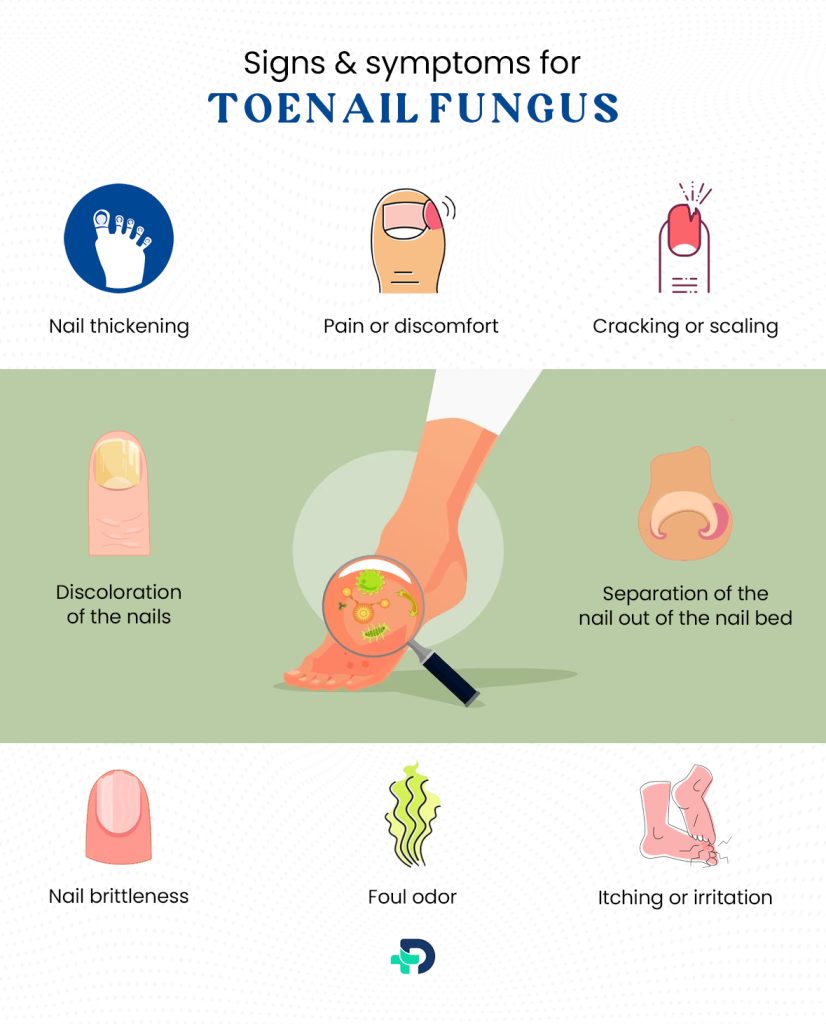Understanding and Managing Toe nail fungus

- Toenail fungus
- 01 Sep 2023
Overview
Overview
Onychomycosis (OM) is a fungal infection of the fingernails or toes that can affect one or more nails. It causes the nail to change color, peel off, and grow thicker. Any part of the nail unit can be affected, like the nail plate, the nail matrix, and the nail bed. OM is more common in people over 60 years and in people with athlete’s foot, nail psoriasis or injuries, diabetes, or a weak immune system. Healthy fingernails are pink, shiny, and smooth, but fungus infection can make them turn yellow, thick, rigid, and even painful. 1Overview | Researched based study from National Institutes of Health

Causes
What causes Toenail Fungus?
Toenail fungus can be caused by a number of things, including:
- Fungal exposure
- Microscopic breaks
- Warm and damp weather
- Having less immunity
- Aging
- Poor circulation
- Unclean feet
- Athletes foot
- Nail trauma
- Hereditary predisposition
Fungal Exposure
- Fungi that cause fingernail infections are often found in warm, damp places like swimming pools, changing rooms, public showers, and saunas.
Microscopic Breaks
- Small cuts, tears, or spaces across the nail and the nail bed can allow fungus to get in.
- These breaks can be triggered by small accidents, shoes that are too tight, or even how you care for your nails.
Warm and damp weather
- Fungi do well in warm, damp places. By holding wetness against the skin and nails, shoes with closed toes and socks can make it easy for fungi to grow.
Having less immunity
- If your immune system is weak, if you have Diabetes, HIV, and some auto-immune diseases all make it harder for the immune system to fight off illnesses.
Aging
- As people get older, their nails can get weaker and more likely to break. This can make them more likely to get a fungal infection.
Poor Circulation
- Circulation problems, like peripheral artery disease, can make it hard for blood to get to the toes and other parts of the body.
- Thus, it may be harder for the immune system to find and fight fungus diseases.
Unclean feet
- Toenail fungus can happen if you don’t take care of your feet well, like by not keeping them clean and dry.
Athlete’s Foot
- A fungus infection called athlete’s foot affects the skin within the toes. It can spread to the toes and cause onychomycosis if you don’t treat it.
Nail Trauma
- Injuries to the toenail, like stubbing your toe or putting something heavy on it, can make it easier for fungus to grow.
Hereditary Predisposition
- Some people may be more likely to get fungal diseases because of something in their genes.
Toenail fungus is contagious. To stop the illness from getting worse and expanding to other nails or people, it’s important to find it and treat it right away. 2Causes | Researched based study from National Library of Medicine
Symptoms

Signs and symptoms
Some of the common symptoms of toenail fungus are:
- Nail thickening
- Pain or discomfort
- Unusual shape of the nails
- Discoloration of the nails (Yellowing or browning)
- Separation of the nail out of the nail bed
- Nail brittleness
- Foul odor
- Cracking or scaling
- Spread of fungus from one nail to the other
- Itching or irritation
Depending on the severity, these signs can be mild or severe.
Types
Types of toenail fungus
Toenail fungus is seen in different types, such as:
- Distal subungual
- White superficial
- Canada
- Proximal subungual
Distal subungual
- This is one of the most common types of fungal infection of the toenail fungus.
- Dermatophytes cause distal subungual toenail fungus.
- Dermatophytes can only grow in places that make keratin, like hair cells and nails.
White superficial
- This is not a dermatophyte, and it affects the nail’s top layer instead of the pores.
Candida
- It occurs due to too much yeast.
- It’s the type of toenail fungus that happens least often.
Proximal subungual
- This is caused by dermatophytes that grow at the base of the nail and sometimes on the top of the foot.
- People with the human immunodeficiency virus (HIV) are more likely to get it than other people.
Risks
Onychomycosis (toenail fungus) has risk factors like: 3Risks | Researched based study from Centers for Disease Control and Prevention
- Trauma
- Food hygiene
- Tight shoes.
- Humidity
- Circulation problems.
- Nail conditions
- Public spaces
- Peripheral neuropathy.
- Shared items
Trauma
- Nail injuries like stubbed toes or repeated pressure may enable fungus to enter and cause infections.
Foot hygiene
- Fungal growth may occur in dirty, wet feet.
Tight shoes
- Tight shoes that don’t let your feet breathe might trap moisture and promote fungal growth.
Humidity/Moisture
- Communal showers, swimming pools, and sweaty shoes might raise the risk of fungal infections.
Circulation Problems
- Diabetes and peripheral vascular disease may impair blood circulation, making fungal infections harder to fight.
Nail Conditions
- Psoriasis and nail dystrophies may allow fungus to thrive beneath nails.
Public Spaces
- Walking barefoot in gyms, pools, and locker rooms increases fungal spore exposure.
Peripheral Neuropathy
- Diabetes-related nerve loss in the foot may cause injuries and make fungal infections difficult to identify and treat.
Shared Items
- Sharing nail clippers, files, or shoes with a fungal patient may infect you.
Diagnosis
Diagnosis of toe nail fungus
If you think you might have toenail fungus, you should see a doctor to get an accurate diagnosis and treatment. Here are some of the most popular investigations : 4Diagnosis | Researched based study from Public Health England
Examination of the body
- Your doctor or nurse will examine your toes. They might look for things like darkening, cracking, thickening, or changes in the shape of the nails.
Test for potassium hydroxide (KOH)
- A small piece of the defective nail is taken and treated with potassium hydroxide.
- This helps break down the nail material and makes it easier to look for fungal parts under a microscope.
Nail Culture
- Sending a nail scrape to a lab to know the fungal growth is one way to do this. This helps in knowing the causative fungus.
Microscopy of the nail
- A doctor might look at a sample of the nail directly with a microscope to see if it has hyphae or spores, which are parts of fungus that look like threads.
PCR Testing
- Polymerase Chain Reaction (PCR) testing is a genetic method that can find the DNA of the fungus that is causing the infection.
Skin examination
- Dermoscopy is a way to look at the nail and the skin around it with the help of a special magnifying tool.
- It can help figure out how the infection is spreading and what it looks like.
Histopathological study
- A small piece of the nail may be physically removed and sent for a histopathological study.
- The tissue is looked under a microscope to see the spread of fungus.
Management
Management of Toe nail fungus
The following are some typical methods for treating toenail fungus: 5Management | Researched based study from American Academy of Dermatology Association
Antifungal Topical Drugs
- Direct application of antifungal creams, lotions, or nail lacquers with over-the-counter or prescription strength is possible.
- These drugs prevent the fungus from growing.
Antifungal Oral Medicines
- Only once a fungal infection has been confirmed then oral antifungal medication can be recommended.
Laser Treatment
- Laser therapy uses focused light to both remove and stop the development of the nail fungus.
- There are several laser treatment options, which may have an impact on how well a person responds to the therapy.
Nail removal
- For severe instances of toenail fungus, surgical removal of the toenail, also known as a nail avulsion of nail plate avulsion, is done.
- Surgery to remove the infected nail may be considered in serious situations if the infection is causing considerable pain or discomfort.
Natural Remedies to manage toenail fungus
Home solutions for toenail fungus might not always completely get rid of the problem, but they can sometimes help with mild cases. It’s important to remember that results may vary from person to person, and it’s always a good idea to talk to a doctor before trying any home remedies.
Here are some natural remedies for toenail fungus
- Apple cider vinegar is believed to kill fungi.
- In a bowl, mix equal amounts of water and apple cider vinegar.
- Soak the feet for 15 to 20 minutes every day.
- Then, dry the feet well.
Tea Tree Oil
- Tea tree oil can kill fungi and may help stop them from growing.
- Mix a few drops of tea tree oil with a carrier oil, like olive oil or coconut oil.
- Use a cotton ball to put the paste on the damaged nails.
Coconut Oil
- Put coconut oil on the damaged nails and the skin around them. Coconut oil is antibacterial.
Oregano Oil
- Oregano oil has antifungal qualities because it has thymol and carvacrol in it
- Combine a few drops of oregano oil with a neutral oil
- Put the mixture on the nails that are infected
Toenail fungus can be hard to get rid of, and home treatments might not work for everyone or in every situation. If your toenail fungus doesn’t go away or gets worse, you should see a doctor to get a good evaluation and treatment.
How can I tell If my toenail fungus is improving?
- You’ll know the medicine is working and the toenail fungus is dying when your toenail changes back to its natural color, gets thinner, grows a healthy new nail, and you can see a clear line between the infected part of the toenail and the new nail growth.
Diet when suffering from toenail fungus:
Diet may not be the main component in curing toenail fungus (onychomycosis), but it may improve your immune system and general health. Be aware of your diet since certain foods may increase fungus development.
Toenail fungus sufferers should avoid these foods:
- Processed and sugary foods
- Refined carbs
- Alcohol
- Dairy products
- Yeast-containing foods
- Moldy Foods
- Fried and processed foods
Instead of just avoiding foods, try these:
- Antioxidant-rich foods: Colorful fruits and vegetables give immune-boosting vitamins and minerals.
- Probiotic-Rich Foods: Probiotics may help your body fight fungal infections by maintaining gut flora. Kefir, sauerkraut, kimchi, and yogurt contain probiotics.
- Lean proteins: Fish, poultry, beans, and lentils include immune-boosting elements.
- Healthy Fats: Avocados, nuts, seeds, and olive oil enhance skin health and general well-being.
- Whole grains: Brown rice, quinoa, and whole wheat provide more fiber and minerals than processed grains.
Complications
Complications of toenail fungus
The complications of toenail fungus can be:
- Difficulty in walking
- Bacterial infections
- Cellulitis
- Onycholysis
- Changes to the nails
- Detachment
- Chronic infection
Difficulty in Walking
- When toenail fungus gets bad enough, it can change the shape and length of the nails, making it hard to walk or do other physical activities.
Bacterial infections
- Fungal infections can make the nails weak and leave holes (perforate) where bacteria can get in. This could lead to bacterial infections in the area.
Cellulitis
- Cellulitis is a bacterial skin infection that causes redness, swelling, warmth, and pain.
Onycholysis, or ingrown toenails
- Onycholysis is when the nail pulls away from the nail bed.
Changes to the nails
- Toenail fungus can cause lasting changes to the look and feel of the nails, making them thick, scarred, and weak if it is not treated well.
Detachment
- In severe cases, the toenail may become so loose that it falls off on its own.
Chronic Infection
- Some cases of toenail fungus can last for years if they are not treated properly. Chronic infections are usually harder to deal with and may need more forceful treatments.
If you think you have toenail fungus, it’s important to get help and care from a doctor to reduce the risk of problems.
Prevention
Ways to prevent Toe nail Fungus
- Never enter a public shower, locker room, or swimming pool without wearing shower shoes. 5Prevention | Researched based study from American Academy of Dermatology Association
- Use a separate shower or shower while wearing flip-flops to prevent being infected with foot or nail fungus if a family member in your home already has it.
- Nail trauma caused by inadvertent trimming might create openings that the fungus can enter through.
- Nail clippers should be cleaned before each use.
- Avoid wearing others shoes.
- Keep your nail clippers and scissors to yourself.
- Toenails shouldn’t be ripped or torn on purpose.
- If you have diabetes, it’s important to take special care of your feet as directed by your doctor.
- Try to avoid getting your feet wet. Always make sure your feet are completely dry after a shower.
- Before trimming your toenails, soak your feet in warm water. You might also wait until after a bath or shower to trim your nails.
- Do not round the corners while cutting toenails.
- Sterilize nail clippers and pedicure implements before using them.
- Always check the salon’s sanitation practices before getting a pedicure, and remember to clean and dry your feet when you get home.
- Nails that are infected should not be painted.
- Put on a pair of well-fitting shoes. The toe area shouldn’t be overly roomy or too snug.
Takeaway
Takeaway
Different microorganisms can cause toenail fungus. The fungus gets into your toes when the nail is hurt or broken, and it grows. Tinea unguium, or toenail fungus, is a very common illness that can be hard to treat. Tinea unguium doesn’t usually hurt, but it might make you feel bad about how your foot looks. Fungal diseases of the toenails can also be avoided by keeping your feet clean and covered and knowing if you have any risk factors. 6Takeaway | Researched based study from National Library of Medicine
Any feedback on this article?
 This Articles content was accurate
This Articles content was accurate Very Informative Article
Very Informative Article I have a question or a comment
I have a question or a comment
 This article contains inaccurate content
This article contains inaccurate content This article was not helpful
This article was not helpful I have a question or a comment
I have a question or a comment
We appreciate your helpful feedback!
Checkout our social pages
References
-
The National Health Service
1. Overview
-
National Library of Medicine
2. Causes
-
Centers for Disease Control and Prevention
3. Risk Factors
-
Public Health England
4. Diagnosis
-
American Academy of Dermatology Association
5. Treatment | Prevention
-
National Library of Medicine
6. Takeaway





































